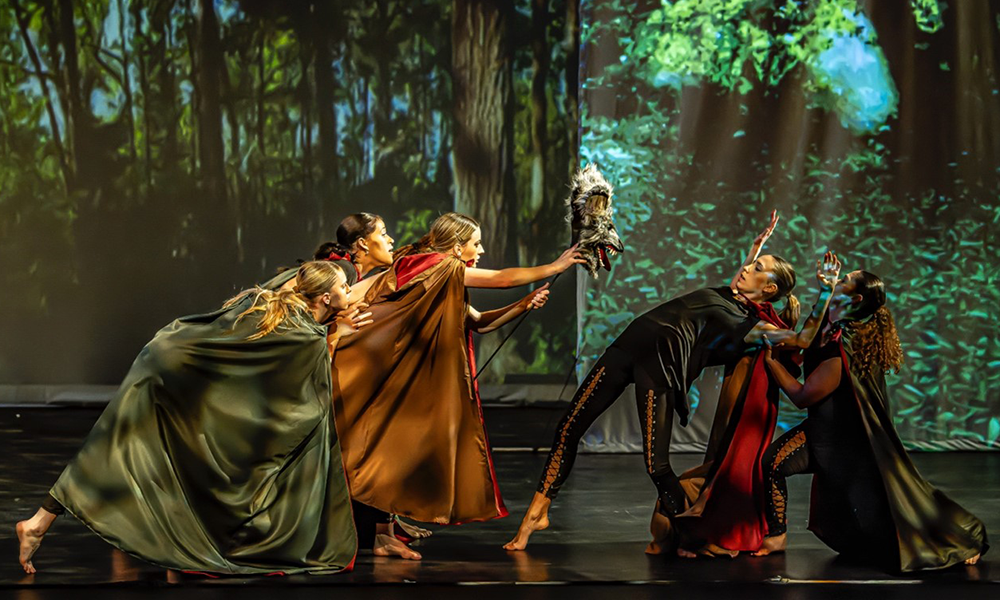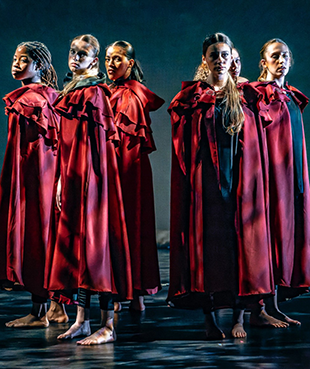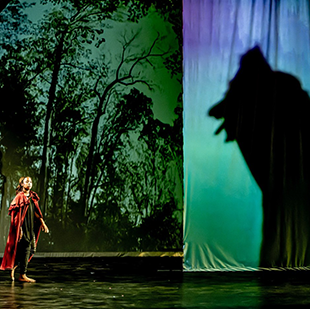From theater stage to 360° screen
News
SUMMARY: A large-scale collaboration among JMU students, faculty and international artists brings together a unique performance of a "Little Red Riding Hood" retelling, developing the project from theater stage to the 360° display of the planetarium — even the movie screen.
In Fall 2024, JMU hosted the premier of an ambitious, interdisciplinary, and multimedia project titled Under the Wolf's Cloak, a rewritten feminist version of “Little Red Riding Hood,” conceived by a team of creative JMU faculty in film, dance, and literature. Associate professor Imelda O’Reilly (Media Arts and Design), assistant professor Tara Lee Burns (Theatre and Dance), instructor Molly O’Donnell (English) and cinematographer and filmmaker Joe Foley orchestrated a large-scale collaboration among JMU students, faculty and international artists.
The team used narrative layering to explore feminism and fairytales by developing the project across multiple platforms: a staged theatrical production, a 360° Virtual Reality film and a 16 X 9-format film, i.e., in the aspect ratio of a full movie theater screen.
 After meeting through a Center for Faculty Innovation mentorship program, filmmaker and poet O’Reilly and dance choreographer Burns hatched a plan to collaborate on a multimedia project with Foley, who proposed creating a 360° Virtual Reality art film to screen in JMU’s John C. Wells Planetarium. “I see this medium as an extension of cinema,” Foley says. “It is truly immersive and grounds the viewer in participatory storytelling while expanding the audience’s imagination.” Associate professor Geary Albright (Physics and Astronomy) facilitated the screening at the Planetarium, where he serves as director.
After meeting through a Center for Faculty Innovation mentorship program, filmmaker and poet O’Reilly and dance choreographer Burns hatched a plan to collaborate on a multimedia project with Foley, who proposed creating a 360° Virtual Reality art film to screen in JMU’s John C. Wells Planetarium. “I see this medium as an extension of cinema,” Foley says. “It is truly immersive and grounds the viewer in participatory storytelling while expanding the audience’s imagination.” Associate professor Geary Albright (Physics and Astronomy) facilitated the screening at the Planetarium, where he serves as director.
The project’s foundational text is O’Reilly’s poem titled “Under the Wolf’s Cloak,” which explores ancestral trauma, the legacy of patriarchy, and the wider community’s culpability; as one refrain goes, “But they knew, they all knew.” O’Donnell, inspired by Angela Carter’s The Bloody Chamber, scripted a response to the poem that uses the “well-trod ground” of the fairytale to consider what feminism means now. O’Reilly then edited O’Donnell’s script to form a Greek Chorus sung and recorded by the South America-based Macrófona choir.
Burns, meanwhile, enjoyed the challenge of choreographing for a new medium and perspective. The 26 student dancers collectively acted as the Wolf, Little Red, her grandmother, the villagers and the woods, at times embodying a single entity together and, at others, playing discrete roles. They followed a structured “cloak-ography” to enable their reversible costumes, red on one side and either brown or green on the other, to evoke the many parts.
For the choreography, Burns “visualized a kaleidoscope, where the dancers were creating shapes and imagery in full circle. In one section, the dancers used the same 10 words in different orders to create unique movements that came from the text.” A recording of O’Reilly reading the poem — set to original music by composer Gene Pritsker — played during the performance, inviting the audience to watch and listen simultaneously to the overlapping yet distinct art forms.
 These elements were part of both the film and stage versions, but the experiences of orchestrating and performing in those contexts were radically different. The camera used to create the hypnotic, transcendent experience of the 360° VR film, for example, is volleyball-sized with six cameras inside. Unlike on a traditional stage, the performers had to direct the action around the circumference of the ball.
These elements were part of both the film and stage versions, but the experiences of orchestrating and performing in those contexts were radically different. The camera used to create the hypnotic, transcendent experience of the 360° VR film, for example, is volleyball-sized with six cameras inside. Unlike on a traditional stage, the performers had to direct the action around the circumference of the ball.
One dancer, Mackenzie Seifert (‘25), said, “Getting to work with the 360° camera was such a cool and unique opportunity unlike anything I have ever done before. Having no offstage or backstage and being fully visible to the ‘audience’ always was a challenge I had to work through.” For the September screenings in the Planetarium, student performers saw their work projected onto the dome and participated in a Q&A with other students and faculty.
With funding from the Virginia Repertory Dance Company, the team then adapted and developed the project into a production they performed in November 2024 at the Forbes Center for the Performing Arts. Involving students at every turn, O'Reilly tasked students in her Producing and Directing course with filming the staged version. The production culminated in a theatrical release, accompanied by live narration and music by Composers Concordance, in Manhattan at Westbeth Artists Community, the world’s largest artists’ housing community where O’Reilly is a resident.
The scale of the project’s production and reach is difficult to fathom. The multidisciplinary JMU team relied on the expertise of a network of renowned professionals beyond JMU — composers, musicians, costume designers, film editors and technicians — and benefited from collaboration and support across JMU and the Harrisonburg community.
